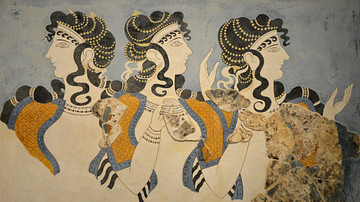Throughout history, fashion has served as a reflection of cultural identity and societal values. In the context of the Bronze Age, two ancient civilizations – the Minoans and Mycenaeans – stand out for their remarkable sense of style. This article delves into the captivating world of Minoan and Mycenaean fashion, shedding light on their distinctive aesthetics, materials used, and symbolic significance.
A Glimpse into Minoan Attire: Unveiling Elegance Amidst Complexity
Minoan fashion was characterized by its intricate designs and vibrant colors that celebrated nature’s bounty. The women adorned themselves with flowing garments made from luxurious fabrics such as silk or linen, often embellished with elaborate patterns inspired by marine life or floral motifs. These exquisite textiles were skillfully dyed using natural pigments derived from plants or minerals found in Crete’s fertile lands.
Moreover, accessories played a pivotal role in completing an ensemble. Intricately crafted jewelry featuring gold, silver, precious stones like lapis lazuli or amethysts adorned necks, wrists, and ears alike. Such opulent adornments not only showcased wealth but also symbolized social status within the hierarchical structure prevalent during this era.
Mycenaean Fashion: A Fusion of Power and Grace
In contrast to the flamboyant elegance seen in Minoan attire, Mycenaean fashion exuded strength through simplicity. Men predominantly wore tunics made from woolen fabric known as peplos while women donned long-sleeved dresses called chitons that accentuated their figures modestly yet gracefully.
The color palette favored earthy tones such as ochre, brown, and deep reds. These hues were often complemented by intricate embroidery or decorative motifs inspired by nature or geometric patterns. The Mycenaeans also displayed their affinity for jewelry, with gold being the preferred metal of choice. Elaborate diadems, brooches, and bracelets adorned both men and women alike.
The Symbolic Significance: Unveiling Cultural Narratives
Both Minoan and Mycenaean fashion held profound symbolic meanings that extended beyond mere aesthetics. In Minoan culture, clothing choices conveyed social status as well as religious beliefs. The depiction of deities on garments emphasized a connection between humans and the divine realm while simultaneously showcasing artistic prowess.
Similarly, in Mycenaean society, attire served as a visual representation of power dynamics within the ruling elite. The regal appearance achieved through carefully selected fabrics and accessories reinforced notions of authority while also establishing alliances through diplomatic exchanges.
A Timeless Legacy: Appreciating Bronze Age Fashion Today
The enduring allure of Minoan and Mycenaean fashion lies not only in its aesthetic appeal but also in its ability to provide insights into ancient civilizations’ values and aspirations. By examining these sartorial choices meticulously crafted centuries ago, we gain a deeper understanding of human creativity’s timeless nature – an appreciation that transcends borders and time itself.

